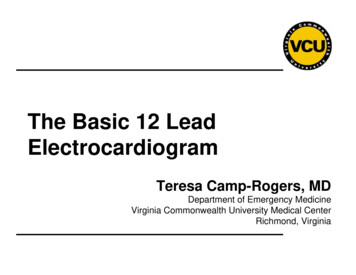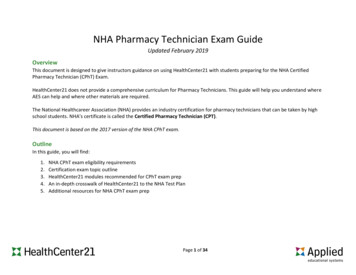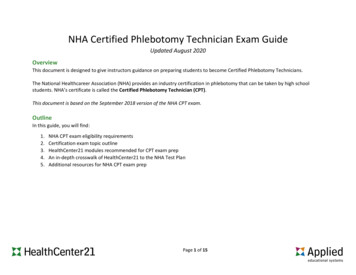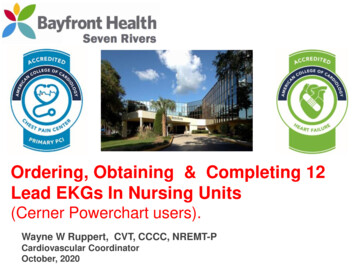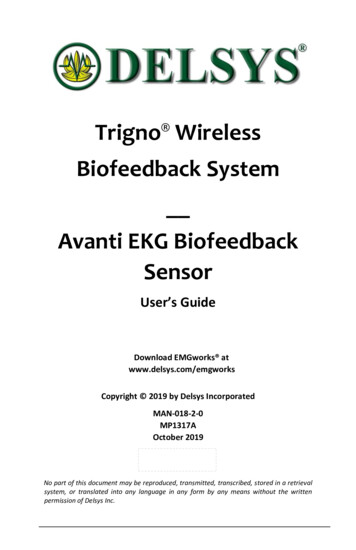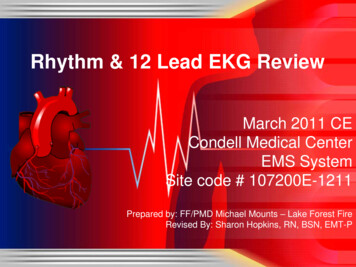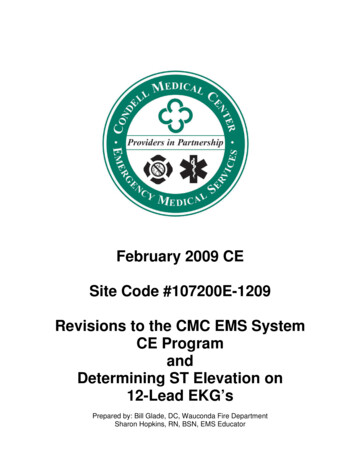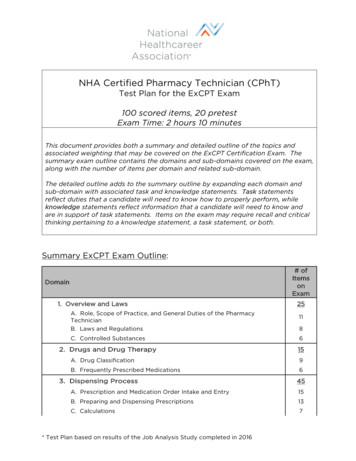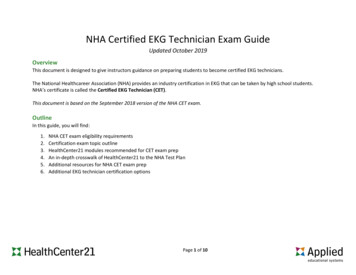
Transcription
NHA Certified EKG Technician Exam GuideUpdated October 2019OverviewThis document is designed to give instructors guidance on preparing students to become certified EKG technicians.The National Healthcareer Association (NHA) provides an industry certification in EKG that can be taken by high school students.NHA’s certificate is called the Certified EKG Technician (CET).This document is based on the September 2018 version of the NHA CET exam.OutlineIn this guide, you will find:1.2.3.4.5.6.NHA CET exam eligibility requirementsCertification exam topic outlineHealthCenter21 modules recommended for CET exam prepAn in-depth crosswalk of HealthCenter21 to the NHA Test PlanAdditional resources for NHA CET exam prepAdditional EKG technician certification optionsPage 1 of 10
1. Eligibility Requirements for the NHA CET ExamIn order to sit for the NHA CET exam, students must have all of the following:1. A high school diploma or GED equivalency2. EKG training that includes performing at least 10 EKGs on live patients within the past 5 years3. 1-year of supervised work experience with EKGsHigh school students may earn provisional certificates prior to graduation. Key information to note includes:1. High school students who meet eligibility requirements must register for the exam within 12 months before graduation2. A provisional certificate expires 12 months from the exam date3. After graduation, graduates may apply to convert the active provisional certificate to a full certificate2. NHA CET Exam Topic OutlineCore knowledge for an EKG technician includes three parts:1. Basic anatomy and physiology of the heart2. Emergencies related to cardiac testing: syncope, chest pain, abnormal vitals, etc.3. Cardiopulmonary resuscitation and basic life supportThe NHA CET exam measures this knowledge by asking questions across three domains:1. Safety, Compliance, and Coordinated Patient Care - 32 questions2. EKG Acquisition - 44 questions3. EKG Analysis and Interpretation - 24 questionsFor more details on the NHA CET exam content, see www.nhanow.comPage 2 of 10
3. HealthCenter21 Modules Recommended for CET Exam PrepHealthCenter21 has 10 modules that will help your students pass the CET exam.Each of the following modules aligns with one or more items listed on the NHA CET Test Plan:1. Anatomy and Physiology2. CPR and Basic Life Support3. Client Status4. Communications5. Electrocardiography6. Health Information Technology7. Infection Control8. Legal and Ethical Responsibilities9. Medical Office Assistant10. Safety PrecautionsSee the next page for an in-depth crosswalk between HealthCenter21 and the NHA CET Test Plan.The coverage of each topic within HealthCenter21 is broken down as being High, Medium, Low, or Not Covered.Page 3 of 10
4. Crosswalk Between NHA EKG (CET) Test Plan & HealthCenter21Domain 1: Safety, Compliance, and CoordinatedPatient CareHealthCenter21 LocationHealthCenter21 Coverage(32 Items)A. Adhere to HIPAA regulations.Supporting Knowledge1. HIPAA regulationsB. Adhere to infection control practices (e.g., OSHA, universalprecautions).Supporting Knowledge1. Guidelines regarding infection control (e.g., OSHA,universal precautions)C. Adhere to scope of practice and comply with ethical standards.Supporting Knowledge1. Scope of practice of the EKG technician2. Ethical standards related to the practice of EKGtechnicians (e.g., NHA Code of Ethics)D. Communicate appropriately with patients and members of themultidisciplinary health care team.Supporting Knowledge1. Communication methods and techniques2. Factors that affect communication with patients (e.g.,culture, language, religion, developmental level, gender,disability)3. Roles and responsibilities of members of theinterdisciplinary health care teamE. Obtain and interpret patient vital signs.Supporting Knowledge1. Emergencies related to cardiac testing (e.g., syncope,chest pain, abnormal vitals)2. Methods for obtaining vital signs3. Normal vital signs across the lifespanModule: Health Information TechnologyHighModule: Legal and Ethical ResponsibilitiesModule: Infection ControlHighModule: Safety PrecautionsModule: ElectrocardiographyUnit 3, Lesson 4Module: Legal and Ethical ResponsibilitiesUnit 4, Lesson 2HighEthical standards and scope ofpractice are not covered in detail.Module: CommunicationsModule: ElectrocardiographyUnit 6 - Communication ExerciseHighModule: Client StatusModule: CPR and Basic Life SupportModule: ElectrocardiographyUnit 3, Lesson 4Page 4 of 10High
F. Instruct patients about preparation for and expectations duringstress testing.Supporting Knowledge1. Patient preparation for stress testing2. Types of stress testsG. Instruct patients on use of ambulatory monitoring (e.g., Holter,event), and verify their understanding.Supporting Knowledge1. Instructions for patient use of ambulatory monitors2. Types of ambulatory monitorsH. Utilize electronic medical records/electronic health records(EMR/EHR) to input patient information (e.g., patient history,medications, vitals, completed EKG).Supporting Knowledge1. Basic elements and processes related to electronicmedical records/electronic health records (EMR/EHR)(e.g., fields, transmit or upload results)I. Recognize signs and symptoms of cardiopulmonary compromise.Supporting Knowledge1. Emergencies related to cardiac testing (e.g., syncope,chest pain, abnormal vitals)2. Cardiopulmonary resuscitation and basic life support3. Normal vital signs across the lifespan4. Signs or symptoms of cardiopulmonary compromiseDomain 2: EKG Acquisition(44 Items)A. Maintain EKG equipment (e.g., load paper, replace clips,disinfect machines and leads).Supporting Knowledge1. EKG equipment maintenance and cleaning requirements(e.g., paper loading, clip replacement, machine and leaddisinfection)Module: ElectrocardiographyUnit 5, Lesson 1HighModule: ElectrocardiographyUnit 5, Lesson 2HighModule: Health Information TechnologyModule: Medical Office AssistantUnit 1, Lessons 1-3Module: CPR and Basic Life SupportHealthCenter21 LocationModule: ElectrocardiographyUnit 3, Lesson 4Page 5 of 10HighHighHealthCenter21 CoverageHigh
2. Supplies needed to perform or assist in cardiac tests3. Equipment needed to perform or assist in cardiac testsB. Verify EKG machine settings (speed, gain).Supporting Knowledge1. Machine settings for acquiring tracing (e.g., speed, gain)C. Prepare skin for electrode placement.Supporting Knowledge1. Supplies needed to perform or assist in cardiac tests2. Methods to prepare the skin for application of EKGelectrodesD. Position patient for cardiac testing (e.g., 3-, 5-, 12-lead, stresstest, telemetry).Supporting Knowledge1. Positioning considerations for special patientpopulations (e.g., amputees, respiratory issues, lateterm pregnancy)2. Positioning protocols for specific cardiac testsE. Apply electrodes and attach leads for:1. Standard 12-lead EKG2. Ambulatory (e.g., Holter, event) monitoring3. Stress testing4. Telemetry5. Patients who have special considerations (e.g., right-sidedheart, posterior chest, amputations, pediatric)Supporting Knowledge1. Basic anatomy and physiology of the heart2. Location of electrode application for various cardiactests3. Lead placement and troubleshooting4. Types of EKG acquisition (e.g., 3-, 5-, 12-lead, stress test,telemetry)5. Types of cardiac monitoring (e.g., ambulatory,stationary)Module: ElectrocardiographyUnit 3, Lesson 2HighModule: ElectrocardiographyUnit 3, Lesson 4HighModule: ElectrocardiographyUnit 3, Lesson 3 & 4HighModule: ElectrocardiographyUnit 3, Lesson 4HighModule: ElectrocardiographyUnit 5, Lessons 1 & 2Page 6 of 10
F. Verify that all leads were recorded.Supporting Knowledge1. Lead placement and troubleshooting2. Elements of complete EKG tracingG. Identify and resolve artifacts from the tracing (e.g., wanderingbaseline, somatic, electrical).Supporting Knowledge1. Causes and types of artifacts (e.g., wandering baseline,somatic tremor, AC interference)2. Methods to resolve artifactsH. Mount a completed EKG tracing strip for patient's chart.Supporting Knowledge1. Mounting EKG rhythm stripsI. Assist in monitoring patient condition during stress testing.Supporting Knowledge1. Emergencies related to cardiac testing (e.g., syncope,chest pain, abnormal vitals)2. Signs of adverse reaction during stress testing (e.g.,shortness of breath, chest pain, abnormal vitals)J. Provide support in responding to complications during stresstesting.Supporting Knowledge1. Emergencies related to cardiac testing (e.g., syncope,chest pain, abnormal vitals)2. Cardiopulmonary resuscitation and basic life support3. Signs of adverse reaction during stress testing (e.g.,shortness of breath, chest pain, abnormal vitals)Module: ElectrocardiographyUnit 2, Lesson 2HighModule: ElectrocardiographyUnit 3, Lesson 3HighModule: ElectrocardiographyUnit 3, Lesson 4HighModule: ElectrocardiographyUnit 5, Lesson 1HighModule: ElectrocardiographyUnit 1, Lesson 3HighPage 7 of 10
Domain 3: EKG Analysis and Interpretation(24 Items)HealthCenter21 LocationHealthCenter21 CoverageA. Calculate patient's heart rate from the EKG tracing.Supporting Knowledge1. Formulas to determine maximum and target heart rates2. Methods to calculate heart rate (e.g., 6-second method,R-R interval, sequencing)3. Units of measurement of graph paperModule: ElectrocardiographyUnit 4, Lesson 2HighB. Determine the regularity of the patient's heart rhythm from theEKG tracing.Supporting Knowledge1. Regular and irregular heart rhythms2. Units of measurement of graph paperModule: ElectrocardiographyUnit 4, Lesson 2HighC. Measure EKG intervals and waveforms (e.g., PR interval [PRI],QRS duration, QT interval).Supporting Knowledge1. Basic anatomy and physiology of the heart2. Electrical conduction3. Techniques for measuring waveforms4. Units of measurement of graph paperModule: ElectrocardiographyUnit 1, Lesson 2HighModule: ElectrocardiographyUnit 1, Lesson 2HighModule: ElectrocardiographyUnit 4, Lesson 1HighD. Inspect the waveform characteristics (P waves, QRS complexes,ST segments, T waves) for symmetry, direction, and amplitude.Supporting Knowledge1. Normal and abnormal waveform duration and intervals2. Normal and abnormal waveform characteristics3. Electrolyte abnormalitiesE. Identify arrhythmias (sinus, atrial, ventricular, junctional, heartblocks) from the EKG tracing.Supporting Knowledge1. Basic anatomy and physiology of the heart2. Emergencies related to cardiac testing (e.g., syncope,chest pain, abnormal vitals)Page 8 of 10
3. Types of arrhythmias (sinus, atrial, ventricular,junctional, heart blocks)F. Recognize pacemaker spikes on an EKG tracing.Supporting Knowledge1. Spikes caused by pacemakersG. Identify ischemia, injury, and infarction on the EKG tracing.Supporting Knowledge1. Emergencies related to cardiac testing (e.g., syncope,chest pain, abnormal vitals)2. Normal and abnormal waveform characteristics3. Variances in waveforms related to ischemia, injury, andinfarctionH. Take appropriate action when life-threatening arrhythmias areidentified.Supporting Knowledge1. Emergencies related to cardiac testing (e.g., syncope,chest pain, abnormal vitals)2. Cardiopulmonary resuscitation and basic life support3. Life-threatening arrhythmias (e.g., ventricularfibrillation, ventricular tachycardia)Module: ElectrocardiographyUnit 3HighModule: ElectrocardiographyUnit 4MediumModule: Anatomy & PhysiologyUnit 1Module: ElectrocardiographyUnit 4Module: CPR and Basic Life SupportPage 9 of 10High
5. Additional Resources for NHA CET Exam PrepBecause HealthCenter21 does not cover 100% of the information students need to pass the NHA CET exam, instructors will need toinclude additional supplementary resources.Resources from NHA Video - What It’s Like to Take an NHA Certification PDF - 2017 NHA CET Test PlanStudy Resources EKG Academy - https://ekg.academy/ Practical Clinical Skills - https://www.practicalclinicalskills.com/ekg Study Stack - https://www.studystack.com/flashcard-646322 Quizlet - https://quizlet.com/darby318Online Simulators ACLS Medical Training - ECG Simulator SkillStat - ECG Simulator Dart Sim - ECG Simulator Life in the Fastlane - ECG Library Life in the Fastlane - 100 ECG Quiz ECG Simulator – Create Example ECG Strips6. Additional EKG Technician Certification OptionsInterested in getting students certified, but don’t plan to use the NHA exam?Here are three other options for EKG technician certifications: American Medical Certification Association: EKG Technician CertificationNational Center for Competency Testing: National Certified ECG TechnicianAmerican Education Certification Association: Certified EKG TechnicianPage 10 of 10
6. Additional EKG Technician Certification Options Interested in getting students certified, but don't plan to use the NHA exam? Here are three other options for EKG technician certifications: American Medical Certification Association: EKG Technician Certification National Center for Competency Testing: National Certified ECG Technician
